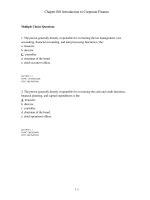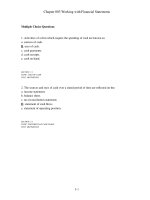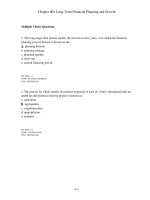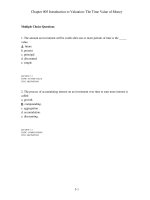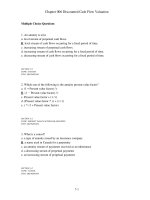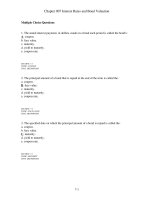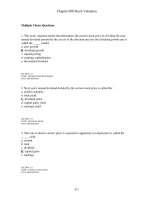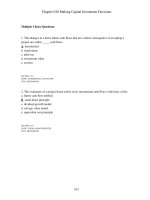Test bank corporate finance 8e ros chap012
Bạn đang xem bản rút gọn của tài liệu. Xem và tải ngay bản đầy đủ của tài liệu tại đây (110.31 KB, 38 trang )
Chapter 012 Some Lessons from Capital Market History
Multiple Choice Questions
1. The excess return required from a risky asset over that required from a risk-free asset is
called the:
A. risk premium.
b. geometric premium.
c. excess return.
d. average return.
e. variance.
SECTION: 12.3
TOPIC: RISK PREMIUM
TYPE: DEFINITIONS
2. The average squared difference between the actual return and the average return is called
the:
a. volatility return.
B. variance.
c. standard deviation.
d. risk premium.
e. excess return.
SECTION: 12.4
TOPIC: VARIANCE
TYPE: DEFINITIONS
3. What is a standard deviation?
a. positive square root of an average rate of return
b. average squared difference between the actual return and the average return
C. positive square root of a variance
d. average return divided by N minus one, where N is the number of returns
e. the square of the variance
SECTION: 12.4
TOPIC: STANDARD DEVIATION
TYPE: DEFINITIONS
12-1
Chapter 012 Some Lessons from Capital Market History
4. What is a normal distribution?
a. a set of returns that lie within one standard deviation of an expected rate of return
b. a set of variances computed over a period of time by comparing actual returns to the
expected rate of return
C. a symmetrical frequency distribution which is defined by its mean and standard deviation
d. the square root of the average squared difference between an actual return and an expected
return
e. the frequency distribution of the average squared excess return over the risk-free rate
SECTION: 12.4
TOPIC: NORMAL DISTRIBUTION
TYPE: DEFINITIONS
5. The average compound return earned per year over a multi-year period is called the _____
average return.
a. arithmetic
b. standard
c. variant
D. geometric
e. real
SECTION: 12.5
TOPIC: GEOMETRIC AVERAGE RETURN
TYPE: DEFINITIONS
6. The return earned in an average year over a multi-year period is called the _____ average
return.
A. arithmetic
b. standard
c. variant
d. geometric
e. real
SECTION: 12.5
TOPIC: ARITHMETIC AVERAGE RETURN
TYPE: DEFINITIONS
12-2
Chapter 012 Some Lessons from Capital Market History
7. An efficient capital market defined as a market in which:
a. trading is free for all participants.
b. taxes are irrelevant.
c. investors earn a zero profit.
d. investors earn a profit on a security equal to the current yield.
E. security prices reflect available information.
SECTION: 12.6
TOPIC: EFFICIENT CAPITAL MARKET
TYPE: DEFINITIONS
8. The notion that capital markets, such as the NYSE, price securities fairly based on available
information is called the:
A. efficient market hypothesis.
b. zero profit hypothesis.
c. open markets theorem.
d. laissez-faire principle.
e. pricing theorem.
SECTION: 12.6
TOPIC: EFFICIENT MARKETS HYPOTHESIS
TYPE: DEFINITIONS
9. Assume that P1 is the purchase cost, P2 represents the sale proceeds, and d represents
dividend income. Given these definitions, which one of the following is the correct formula
for the total return on an equity security?
a. (P2 P1) / P2 + d
b. (P1 P2) / (P2 + d)
c. (P1 P2 d) / P1
D. (P2 P1 + d) / P1
e. (P2 P1 + d) / P2
SECTION: 12.1
TOPIC: TOTAL RETURN
TYPE: CONCEPTS
12-3
Chapter 012 Some Lessons from Capital Market History
10. Which one of the following correctly describes the dividend yield?
A. next year's annual dividend divided by today's stock price
b. this year's annual dividend divided by today's stock price
c. this year's annual dividend divided by next year's expected stock price
d. the annual dividend amount divided by the face value of the stock
e. the increase in next year's dividend over this year's dividend divided by the current stock
price
SECTION: 12.1
TOPIC: DIVIDEND YIELD
TYPE: CONCEPTS
11. Uptown Stores just announced they are increasing their annual dividend from $1.34 per
share to $1.40 per share. If the dividend yield remains at its pre-announcement level, then you
know the stock price:
a. was unaffected by the announcement.
B. increased proportionately with the dividend increase.
c. increased by $0.06 per share.
d. decreased by $0.06 per share.
e. increased by $0.06 (1 + Dividend yield).
SECTION: 12.1
TOPIC: DIVIDEND YIELD
TYPE: CONCEPTS
12-4
Chapter 012 Some Lessons from Capital Market History
12. The capital gains yield considers which of the following?
I. the ending, or sale, price of a security
II. the average price of a security over a stated period of time
III. any dividend income received
IV. the beginning value, or cost, of a security
a. I and III only
b. II and IV only
C. I and IV only
d. I, III, and IV only
e. I, II, III, and IV
SECTION: 12.1
TOPIC: CAPITAL GAIN
TYPE: CONCEPTS
12-5
Chapter 012 Some Lessons from Capital Market History
13. The total return on a security is based on the:
a. arithmetic average change in the price of the security.
b. average of the arithmetic and geometric average changes in the price of the security.
c. dividend yield.
d. capital gains yield.
E. both the dividend yield and the capital gains yield.
SECTION: 12.1
TOPIC: TOTAL RETURN
TYPE: CONCEPTS
14. The real rate of return on a stock is approximately equal to the nominal rate of return:
a. multiplied by (1 + Inflation rate).
b. plus the inflation rate.
C. minus the inflation rate.
d. divided by (1 + Inflation rate).
e. divided by (1 Inflation rate).
SECTION: 12.1
TOPIC: REAL RETURN
TYPE: CONCEPTS
15. As long as the inflation rate is positive, the real rate of return on a security will be ____
the nominal rate of return.
a. greater than
b. equal to
C. less than
d. greater than or equal to
e. unrelated to
SECTION: 12.1
TOPIC: REAL RETURN
TYPE: CONCEPTS
12-6
Chapter 012 Some Lessons from Capital Market History
16. Small-company stocks, as the term is used in the textbook, are defined as the common
stock of:
a. the 500 newest corporations in the U.S.
b. all the firms whose stock trades OTC.
C. the smallest twenty percent of the firms listed on the NYSE.
d. the smallest twenty-five percent of the firms listed on NASDAQ.
e. all the firms whose stock is listed on NASDAQ.
SECTION: 12.2
TOPIC: SMALL COMPANY STOCKS
TYPE: CONCEPTS
17. Which one of the following categories of securities had the highest average return for the
period 1926 – 2005?
a. U.S. Treasury bills
b. large company stocks
C. small company stocks
d. long-term corporate bonds
e. long-term government bonds
SECTION: 12.3
TOPIC: HISTORICAL RECORD
TYPE: CONCEPTS
18. Which one of the following categories of securities had the lowest average risk premium
for the period 1926 – 2005?
a. long-term government bonds
b. small company stocks
c. large company stocks
d. long-term corporate bonds
E. U.S. Treasury bills
SECTION: 12.2
TOPIC: RISK PREMIUM
TYPE: CONCEPTS
12-7
Chapter 012 Some Lessons from Capital Market History
19. On average, for the period 1926 – 2005:
a. the real rate of return on U.S. Treasury bills has been negative.
b. small company stocks have underperformed large company stocks.
c. long-term government bonds have earned a higher real rate of return than have long-term
corporate bonds.
D. the risk premium on U.S. Treasury bills has been zero percent.
e. the risk premium on large company stocks has exceeded the risk premium on small
company stocks.
SECTION: 12.3
TOPIC: RISK PREMIUM
TYPE: CONCEPTS
20. Which one of the following categories of securities has had the most volatile returns over
the period 1926 – 2005?
a. long-term corporate bonds
b. large-company stocks
c. intermediate-term government bonds
d. U.S. Treasury bills
E. small-company stocks
SECTION: 12.4
TOPIC: STANDARD DEVIATION
TYPE: CONCEPTS
21. Over the period 1926 – 2005, the annual rate of inflation:
a. was always positive.
b. was only negative during the Great Depression.
c. never exceeded ten percent.
D. fluctuated significantly from one year to the next.
e. tended to be negative during the years of World War II.
SECTION: 12.2
TOPIC: HISTORICAL RECORD
TYPE: CONCEPTS
12-8
Chapter 012 Some Lessons from Capital Market History
22. Which one of the following time periods is associated with high rates of inflation?
a. 1929 – 1933
b. 1957 – 1961
C. 1978 – 1981
d. 1992 – 1996
e. 1999 – 2002
SECTION: 12.2
TOPIC: HISTORICAL RECORD
TYPE: CONCEPTS
23. Which one of the following statements concerning U.S. Treasury bills is correct for the
period 1926 – 2005?
a. The annual rate of return always exceeded the annual inflation rate.
b. The average risk premium was 1.1 percent.
c. The annual rate of return was always positive.
D. The average excess return was 1.1 percent.
e. The average real rate of return was equal to zero.
SECTION: 12.2 and 12.3
TOPIC: HISTORICAL RECORD
TYPE: CONCEPTS
24. Which one of the following is a correct ranking of securities based on their volatility over
the period of 1926 – 2005? Rank from highest to lowest.
a. large company stocks, U.S. Treasury bills, long-term government bonds
b. small company stocks, long-term corporate bonds, large company stocks
C. small company stocks, long-term government bonds, long-term corporate bonds
d. large company stocks, long-term corporate bonds, long-term government bonds
e. long-term government bonds, long-term corporate bonds, U.S. Treasury bills
SECTION: 12.4
TOPIC: STANDARD DEVIATION
TYPE: CONCEPTS
12-9
Chapter 012 Some Lessons from Capital Market History
25. What was the highest annual rate of inflation during the period 1926 – 2005?
a. 7 percent
b. 10 percent
c. 13 percent
D. 18 percent
e. 22 percent
SECTION: 12.2
TOPIC: HISTORICAL RECORD
TYPE: CONCEPTS
26. The excess return is computed as the:
a. return on a security minus the inflation rate.
B. return on a risky security minus the risk-free rate.
c. risk premium on a risky security minus the risk-free rate.
d. the risk-free rate plus the inflation rate.
e. risk-free rate minus the inflation rate.
SECTION: 12.3
TOPIC: EXCESS RETURN
TYPE: CONCEPTS
27. Which one of the following earned the highest risk premium over the period 1926 –
2005?
a. long-term corporate bonds
b. U.S. Treasury bills
C. small-company stocks
d. large-company stocks
e. long-term government bonds
SECTION: 12.3
TOPIC: RISK PREMIUM
TYPE: CONCEPTS
12-10
Chapter 012 Some Lessons from Capital Market History
28. Over the period of 1926 – 2005, the average rate of inflation was _____ percent.
a. 2.0
b. 2.4
C. 3.1
d. 3.8
e. 4.3
SECTION: 12.3
TOPIC: HISTORICAL AVERAGE RETURNS
TYPE: CONCEPTS
29. Over the period 1926 – 2005, bonds averaged a return of approximately _____ percent
and large-company stocks earned an approximate average return of _____ percent.
a. 5; 10
b. 5; 14
C. 6; 12
d. 6; 14
e. 7; 15
SECTION: 12.3
TOPIC: HISTORICAL AVERAGE RETURNS
TYPE: CONCEPTS
30. The average annual return on small-company stocks was about _____ percent greater than
the average annual return on large-company stocks over the period 1926 – 2005.
a. 3
B. 5
c. 7
d. 9
e. 11
SECTION: 12.3
TOPIC: AVERAGE RETURNS
TYPE: CONCEPTS
12-11
Chapter 012 Some Lessons from Capital Market History
31. What was the average risk premium on U.S. Treasury bills over the period 1926 – 2005?
A. 0.0 percent
b. 1.6 percent
c. 2.2 percent
d. 3.1 percent
e. 3.8 percent
SECTION: 12.3
TOPIC: RISK PREMIUM
TYPE: CONCEPTS
32. Which one of the following is a correct statement concerning risk premium?
A. The greater the volatility of returns, the greater the risk premium.
b. The lower the volatility of returns, the greater the risk premium.
c. The lower the average rate of return, the greater the risk premium.
d. The risk premium is not correlated to the average rate of return.
e. The risk premium is not affected by the volatility of returns.
SECTION: 12.3
TOPIC: RISK PREMIUM
TYPE: CONCEPTS
33. The excess return you earn by moving from a relatively risk-free investment to a risky
investment is called the:
a. real return.
b. inflation premium.
C. risk premium.
d. time value premium.
e. Blume's return.
SECTION: 12.3
TOPIC: RISK PREMIUM
TYPE: CONCEPTS
12-12
Chapter 012 Some Lessons from Capital Market History
34. To convince investors to accept greater volatility in the annual rate of return on an
investment, you must:
a. decrease the risk premium.
B. increase the risk premium.
c. decrease the real return.
d. decrease the risk-free rate.
e. increase the risk-free rate.
SECTION: 12.3
TOPIC: RISK PREMIUM
TYPE: CONCEPTS
35. Which one of the following takes the shape of a bell curve?
A. frequency distribution
b. variance
c. risk premium graph
d. standard deviation
e. squared deviation of returns
SECTION: 12.4
TOPIC: FREQUENCY DISTRIBUTION
TYPE: CONCEPTS
36. The larger the variance, the:
I. more the actual returns differ from the average return.
II. larger the standard deviation.
III. greater the risk.
IV. higher the expected return.
a. I and III only
b. II, III, and IV only
c. I, III, and IV only
d. I, II, and III only
E. I, II, III, and IV
SECTION: 12.4
TOPIC: VARIANCE
TYPE: CONCEPTS
12-13
Chapter 012 Some Lessons from Capital Market History
37. The variance of a series of returns on a security is computed by dividing the sum of the:
A. squared deviations by the number of returns minus one.
b. average returns by the number of returns minus one.
c. average returns by the number of returns plus one.
d. squared deviations by the average rate of return.
e. squared deviations by the number of returns plus one.
SECTION: 12.4
TOPIC: VARIANCE
TYPE: CONCEPTS
38. Which of the following statements concerning the standard deviation are correct?
I. The greater the standard deviation, the lower the risk.
II. The standard deviation is a measure of volatility.
III. The higher the standard deviation, the less certain the rate of return in any one given year.
IV. The higher the standard deviation, the higher the expected return.
a. I and III only
B. II, III, and IV only
c. I, III, and IV only
d. I, II, and III only
e. I, II, III, and IV
SECTION: 12.4
TOPIC: STANDARD DEVIATION
TYPE: CONCEPTS
39. The standard deviation of the returns on small-company stocks for the period 1926 – 2005
indicates that:
a. there is minimal variation in the rate of return from one year to the next year.
B. small-company stocks are more volatile than large-company stocks.
c. stocks are generally less volatile than corporate bonds.
d. the variance of those returns is approximately double the variance of a risk-free security.
e. the frequency of those returns produces a relatively narrow bell curve.
SECTION: 12.4
TOPIC: STANDARD DEVIATION
TYPE: CONCEPTS
12-14
Chapter 012 Some Lessons from Capital Market History
40. Which of the following statements are true?
I. Risk and potential reward are inversely related.
II. There is a reward for bearing risk.
III. Without risk, an investment would earn the U.S. Treasury bill rate.
IV. The greater the potential reward, the higher the risk.
a. I and II only
b. III and IV only
c. II and IV only
D. II, III, and IV only
e. I, II, III, and IV
SECTION: 12.3 and 12.4
TOPIC: RISK AND REWARD
TYPE: CONCEPTS
41. Estimates of the rate of return on a security based on an historical arithmetic average will
probably tend to _____ the expected return for the long-term while estimates using the
historical geometric average will probably tend to _____ the expected return for the shortterm.
a. overestimate; overestimate
B. overestimate; underestimate
c. underestimate; overestimate
d. underestimate; underestimate
e. accurately; accurately
SECTION: 12.5
TOPIC: ARITHMETIC VERSUS GEOMETRIC AVERAGES
TYPE: CONCEPTS
12-15
Chapter 012 Some Lessons from Capital Market History
42. The primary purpose of Blume's formula is to:
a. compute an accurate historical rate of return.
b. determine a stock's true current value.
c. consider compounding when estimating a rate of return.
d. determine the actual real rate of return.
E. project future rates of return.
SECTION: 12.6
TOPIC: BLUME'S FORMULA
TYPE: CONCEPTS
12-16
Chapter 012 Some Lessons from Capital Market History
43. In an efficient market, the price of a security will:
a. always rise immediately upon the release of new information with no further price
adjustments related to that information.
b. react to new information over a two-day period after which time no further price
adjustments related to that information will occur.
c. rise sharply when new information is first released and then decline to a new stable level by
the following day.
D. react immediately to new information with no further price adjustments related to that
information.
e. be slow to react for the first few hours after new information is released allowing time for
that information to be reviewed and analyzed.
SECTION: 12.6
TOPIC: MARKET EFFICIENCY
TYPE: CONCEPTS
44. Which one of the following is indicative of a totally efficient stock market?
a. extraordinary returns earned on a routine basis
b. positive net present values over the long-term
C. zero net present values for all stocks
d. arbitrage opportunities which develop on a routine basis
e. realizing negative returns on a routine basis
SECTION: 12.6
TOPIC: MARKET EFFICIENCY
TYPE: CONCEPTS
45. Which one of the following statements is correct concerning market efficiency?
a. Real asset markets are more efficient than financial markets.
b. If a market is efficient, arbitrage opportunities should be common.
c. In an efficient market, some market participants will have an advantage over others.
D. A firm will generally receive a fair price when it sells shares of stock.
e. New information will gradually be reflected in a stock's price to avoid any sudden change
in the price of the stock.
SECTION: 12.6
TOPIC: MARKET EFFICIENCY
TYPE: CONCEPTS
12-17
Chapter 012 Some Lessons from Capital Market History
46. Financial markets fluctuate daily because:
a. the markets are inefficient.
B. the markets are continually reacting to new information.
c. arbitrage trading occurs daily.
d. every day adds more information to the historical record.
e. traders are unsure of the actual value of any security.
SECTION: 12.6
TOPIC: MARKET EFFICIENCY
TYPE: CONCEPTS
47. Trading on inside information does not offer any advantages if the financial markets are:
a. weak form efficient.
b. semiweak form efficient.
c. semistrong form efficient.
D. strong form efficient.
e. inefficient.
SECTION: 12.6
TOPIC: MARKET EFFICIENCY
TYPE: CONCEPTS
48. According to theory, studying historical stock price movements to identify mispriced
stocks:
a. is effective as long as the market is only semistrong form efficient.
b. is effective provided the market is only weak form efficient.
C. is ineffective even when the market is only weak form efficient.
d. becomes ineffective as soon as the market gains semistrong form efficiency.
e. is ineffective only in strong form efficient markets.
SECTION: 12.6
TOPIC: MARKET EFFICIENCY
TYPE: CONCEPTS
12-18
Chapter 012 Some Lessons from Capital Market History
49. Which of the following statements related to market efficiency tend to be supported by
current evidence?
I. markets tend to respond quickly to new information
II. investors can easily earn excess profits
III. short-run prices are difficult to predict accurately based on public information
IV. markets are most likely only weak form efficient
A. I and III only
b. II and IV only
c. I and IV only
d. I, III, and IV only
e. I, II, and III only
SECTION: 12.6
TOPIC: MARKET EFFICIENCY
TYPE: CONCEPTS
50. If you excel in analyzing the future outlook of firms, you would prefer the financial
markets be ____ form efficient so that you can have an advantage in the marketplace.
A. weak
b. semiweak
c. semistrong
d. strong
e. perfect
SECTION: 12.6
TOPIC: MARKET EFFICIENCY
TYPE: CONCEPTS
12-19
Chapter 012 Some Lessons from Capital Market History
51. Your best friend works in the finance office of Capital Leasing. You are aware that this
friend trades stocks based on information he overhears in the office. You know that this
information is not known to the general public. Your friend continually brags to you about the
profits he earns on these trades. Based on this information, you would tend to argue that the
financial markets are at best _____ form efficient.
a. weak
b. semiweak
C. semistrong
d. strong
e. perfect
SECTION: 12.6
TOPIC: MARKET EFFICIENCY
TYPE: CONCEPTS
52. The U.S. Securities and Exchange Commission periodically charges individuals with
insider trading and claims those individuals have made unfair profits. Based on this fact, you
would tend to argue that the financial markets are at best _____ form efficient.
a. weak
b. semiweak
C. semistrong
d. strong
e. perfect
SECTION: 12.6
TOPIC: MARKET EFFICIENCY
TYPE: CONCEPTS
12-20
Chapter 012 Some Lessons from Capital Market History
53. Individuals who continually monitor the financial markets seeking mispriced securities:
a. earn excess profits over the long-term.
B. make the markets increasingly more efficient.
c. are never able to find a security that is temporarily mispriced.
d. are overwhelmingly successful provided they trade within five minutes of their discovery.
e. are always quite successful using only historical price information as their basis of
evaluation.
SECTION: 12.6
TOPIC: MARKET EFFICIENCY
TYPE: CONCEPTS
12-21
Chapter 012 Some Lessons from Capital Market History
54. One year ago, you purchased a stock at a price of $28.75. The stock pays quarterly
dividends of $.35 per share. Today, the stock is worth $31.25 per share. What is the total
amount of your capital gains to date from this investment?
a. $0.70
b. $1.10
c. $1.40
D. $2.50
e. $3.90
Capital gains = $31.25
$28.75 = $2.50
AACSB TOPIC: ANALYTIC
SECTION: 12.1
TOPIC: DOLLAR RETURNS
TYPE: PROBLEMS
55. Six months ago, you purchased 50 shares of stock in First Place Co. at a price of $41.68 a
share. First Place stock pays a quarterly dividend of $.40 a share. Today, you sold all of your
shares for $44.12 per share. What is the total amount of your dividend income on this
investment?
a. $20
B. $40
c. $80
d. $100
e. $122
Dividend income = ($.40
2)
50 = $40.00
AACSB TOPIC: ANALYTIC
SECTION: 12.1
TOPIC: DOLLAR RETURNS
TYPE: PROBLEMS
12-22
Chapter 012 Some Lessons from Capital Market History
56. A year ago, you purchased 200 shares of Holland Enterprises, Inc. stock at a price of
$15.54 per share. The stock pays an annual dividend of $.20 per share. Today, you sold all of
your shares for $17.70 per share. What is your total dollar return on this investment?
a. $140
b. $160
c. $216
d. $432
E. $472
Total dollar return = ($17.70
$15.54 + $.20)
200 = $472
AACSB TOPIC: ANALYTIC
SECTION: 12.1
TOPIC: DOLLAR RETURNS
TYPE: PROBLEMS
57. You purchased 300 shares of stock at a price of $35.86 per share. Over the last year, you
have received total dividend income of $336. What is the dividend yield?
a. 1.1 percent
B. 3.1 percent
c. 6.8 percent
d. 9.4 percent
e. 10.7 percent
Dividend per share = $336 / 300 = $1.12; Dividend yield = $1.12 / $35.86 = 3.1 percent
AACSB TOPIC: ANALYTIC
SECTION: 12.1
TOPIC: DIVIDEND YIELD
TYPE: PROBLEMS
12-23
Chapter 012 Some Lessons from Capital Market History
58. Bankers, Inc. stock is currently selling for $80 a share. The stock has a dividend yield of
4.2 percent. How much dividend income will you receive per year if you purchase 150 shares
of this stock?
a. $120
b. $336
C. $504
d. $630
e. $1,905
Dividend income = $80
.042
150 = $504
AACSB TOPIC: ANALYTIC
SECTION: 12.1
TOPIC: DIVIDEND YIELD
TYPE: PROBLEMS
59. One year ago, you purchased a stock at a price of $40 a share. Today, you sold the stock
and realized a total return of 30 percent. Your capital gain was $8 a share. What was your
dividend yield on this stock?
A. 10 percent
b. 20 percent
c. 30 percent
d. 40 percent
e. 50 percent
Capital gains yield = $8 / $40 = 20.00 percent; Dividend yield = 30 percent
percent
AACSB TOPIC: ANALYTIC
SECTION: 12.1
TOPIC: DIVIDEND YIELD
TYPE: PROBLEMS
12-24
20 percent = 10
Chapter 012 Some Lessons from Capital Market History
60. You just sold 400 shares of Bosley, Inc. stock at a price of $49.60 a share. Last year you
paid $50.50 a share to buy this stock. Over the course of the year, you received dividends
totaling $1.96 per share. What is your capital gain on this investment?
a. $424
B. $360
c. $360
d. $424
e. $784
Capital gain = ($49.60
$50.50)
400 =
$360 (capital loss)
AACSB TOPIC: ANALYTIC
SECTION: 12.1
TOPIC: CAPITAL GAIN
TYPE: PROBLEMS
61. You purchased 200 shares of Hypex, Inc. stock for $38.12 a share. You have received a
total of $290 in dividends and $8,130 in proceeds from selling the shares. What is your capital
gains yield on this stock?
a. 3.8 percent
b. 4.2 percent
C. 6.6 percent
d. 8.0 percent
e. 10.4 percent
Cost = 200
$38.12 = $7,624; Capital gains yield = ($8,130
AACSB TOPIC: ANALYTIC
SECTION: 12.1
TOPIC: CAPITAL GAIN
TYPE: PROBLEMS
12-25
$7,624) / $7,624 = 6.6 percent
